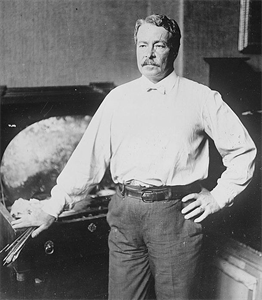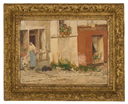American Impressionist Painter
American, (1859–1935) Frederick Childe Hassam discontinued the use of his first name.
Although he disliked being compared to Claude Monet or, at times, being called an impressionist, Childe Hassam was the undisputed leader of the American Impressionist movement and its most successful practitioner. He believed, however, that true impressionism was realism, and that a direct observation of the world inspired the artist to articulate the connection between what he saw and the resulting painted image. Nevertheless, he championed the rapid brushwork, high-keyed tonal palette, and brilliant effects of color and light exemplified by French Impressionism, and he adopted the French interest in modern subjects. In particular, Hassam became the chronicler of the dynamic cityscapes found in Boston and, later, New York City, an interest that at the time was virtually unique among American painters. Perhaps somewhat surprisingly, he also painted in several picturesque villages along the New England coast, often evoking in these works a nostalgic view of a simpler, earlier time.
The son of a wealthy merchant, Frederick Childe Hassam was born on October 17, 1859, in Dorchester, Massachusetts, near Boston, where he studied drawing and watercolor in high school and, beginning in 1876, apprenticed as a woodblock designer for a local wood engraver. (1) He studied drawing and anatomy at the Lowell Institute, a division of the Massachusetts Institute of Technology, and took drawing classes at the Boston Art Club. By the early 1880s Hassam had established a Boston studio, supporting himself as a freelance illustrator of children's books and magazine articles. (2) He had his first one-man exhibition in Boston in 1882, where he exhibited fifty watercolors, many painted in Nantucket the previous summer. After this exhibition, and at the suggestion of his friend, the poet and journalist Celia Laighton Thaxter, Hassam began to sign his art "F. Childe Hassam" until, in 1883, he dropped the initial and used "Childe Hassam." Beginning in 1885 he placed an enigmatic crescent before his signature. (3) In the summer of 1883, he and artist Edmund H. Garrett traveled through Great Britain and Europe to study old masters and make watercolors in the countryside. Impressed by the atmospheric art of J.M.W. Turner, Hassam, when he returned to America, attempted to capture similar effects of light and atmosphere in his depictions of various Boston streetscapes.
Hassam married in 1884 and with his wife returned in 1886 to Paris, where the Hassams lived until 1889 and where he studied at the Académie Julian under the instruction of Gustav Boulanger, Henri Lucien Doucet, and Jules-Joseph Lefebvre. He exhibited in the Paris Salons of 1887 and 1888 and won a bronze medal at the Paris Exposition Universelle of 1889. Dissatisfied with academic training and in direct response to his first-hand examination of French Impressionist canvases, Hassam’s brushwork became more textural and his palette evolved from the nearly monochromatic browns of his earlier work to more vivid, high-keyed colors.
The Hassams returned to America and settled in New York City in 1889, and Hassam found in the dynamic city inspiration for pictorial experiments. Especially his celebrated series of flag paintings, first inspired by a "Preparedness Parade" (for the American involvement in World War I) held on Fifth Avenue. These paintings, created between 1916 and 1919, demonstrated not only his mastery of the vibrant streetscape of New York, but also his fervent patriotism during World War I. In New York, Hassam was actively involved in the city's art community, and he became close friends with the artists John H. Twachtman and J. Alden Weir. He exhibited in New York’s National Academy of Design’s annual exhibition in 1883 and again in 1886 and thereafter remained a consistent contributor. Between 1889 and 1919 he also made extended, productive summer visits to New England coastal towns—in particular Gloucester, Massachusetts, Newport and Provincetown, Rhode Island, and Cos Cob and Old Lyme, Connecticut—until, in 1920, he chose East Hampton, New York, as his exclusive summer home. Among the New England locales that he visited was the island of Appledore, part of the Isles of Shoals, a group of small, rocky islands about ten miles off the New Hampshire coast, near Portsmouth. Hassam was first drawn there, like many fellow artists, writers, and musicians, by his friendship with Celia Laighton Thaxter, whose family owned a hotel on the island.
After returning from a trip to Europe that included a stay in Paris, in 1897 Hassam resigned his membership in the Society of American Artists to join with nine other artists in the formation of Ten American Painters or “The Ten,” a group of American impressionists initiated by the painter John H. Twachtman. The other members were Frank W. Benson, Joseph R. DeCamp, Thomas W. Dewing, Willard L. Metcalf, Robert Reid, Edward E. Simmons, and Edmund C. Tarbell. (When Twachtman died in 1902, he was replaced by William Merritt Chase in 1905.) At their first group show in 1898 at the New York Durand-Ruel Gallery, 1st Exhibition, Ten American Painters, Hassam’s work was dismissed by critics as “too experimental" and “radical.” (4) This criticism notwithstanding, Hassam found buyers, including museums, (5) for his work, and with the growing acceptance of Impressionism at the turn of the century, Hassam’s art began to gain legitimacy with Americans. Paintings by Hassam took gold medals at the Buffalo Pan-American Exposition (1901), the St. Louis Louisiana Purchase Exposition (1904), and at the Society of American Artists (1906), the society Hassam had left nearly a decade before to become a member of The Ten. In 1909, The Metropolitan Museum of Art acquired by gift its first work by Hassam, Coast Scene, Isles of Shoals, (6) and Hassam’s popularity and success continued to grow. By 1920 the sale of his paintings brought him $100,000, (7) or what today would be nearly a million dollars. Childe Hassam died at his East Hampton home on August 27, 1935, at the age seventy-five.
(1) Ulrich W. Hiesinger, Childe Hassam, American Impressionist (New York, 1994), 13.
(2) Ibid., 14
(3) According to Hiesinger, the crescent “may have alluded to the oriental flavor” of Hassam’s name or referred to the crescent sun, “a poetic image used by [Celia] Thaxter to symbolize Hassam’s emerging fame.” Ibid., 17.
(4) Ibid., 116.
(5) He sold paintings to the Cincinnati Art Museum, in 1899, and to the Carnegie Institute in Pittsburgh, in 1900.
(6) Oil on canvas. The Metropolitan Museum of Art, New York. Gift of George A. Hearn, 1909 (09.72.6).
(7) "Art Fund Created by Hassam's Will," The New York Times (November 13, 1935), 18.
Gloucester Inner Harbor HC.P.1920.02.(O)
Isles of Shoals, Appledore HC.D.xxxx.08.(P)
L'Épicerie HC.P.xxxx.83.(O)

.png)
_image01.png)

![Additional Image Photograph of Childe Hassam by Bain News Service, Library of Congress Prints and Photographs Division Washington, D.C. (LC-B2- 4841-9 [P&P])](/Media/Thumbnails/Hassam.png)